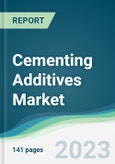The cementing additives market was valued at US$16.635 billion in 2021.
Cementing additives are substances incorporated into cement to enhance or modify its properties, and these additives are introduced during the manufacturing process or mixed with cement before its usage. Their purpose is to improve strength, workability, setting time, durability, or other desired characteristics of the cement. Common cementing additives include cement retarders, dispersants, defoamers, and fluid loss additives used in the oil & gas industry and the construction sector to enhance cement performance and improve wellbore integrity. The increase in oil & gas well construction and growth in construction activities is anticipated to accelerate the demand for cementing additives.Investments in the oil & gas sector are augmenting the demand for cementing additives.
Cementing is a critical process in oil and gas well construction, where cement creates a strong and impermeable barrier between the wellbore and surrounding formations. Cementing additives are vital in this process as they enhance the properties of cement for environmental protection, maximize hydrocarbon recovery, and ensure wellbore integrity. Cementing additives play a crucial role in achieving effective zonal isolation, preventing fluid migration, and maintaining the integrity of the well throughout its operational life. There is a growing trend towards drilling in challenging environments such as high-pressure and high-temperature (HPHT) reservoirs, deepwater wells, and unconventional shale formations in the oil & gas industry. These environments pose unique challenges to wellbore integrity, subjecting the cement sheath to extreme conditions. Cementing additives are crucial in addressing these challenges by providing enhanced strength, improved resistance to thermal & chemical stresses, and increased resistance to gas or fluid migration. The rise in investments to construct new oil & gas wells accelerates the demand for cementing additives. According to the US Energy Information Administration, in 2022, natural gas-directed rigs totaled 160 as of September 30, an increase of 53 so far in 2022, and oil-directed rigs totaled 602, an increase of 481. In 2023, the Oil and Natural Gas Corporation Limited (ONGC) announced an investment of USD 2 billion to construct 103 wells on its main gas-bearing asset in the Arabia Sea. This shows that cementing additives will have a great demand in the future.Growing construction activities are expected to drive market growth.
The demand for high-performance cementing solutions becomes essential as construction projects increase in scale and complexity. Cementing additives play a crucial role in enhancing the properties of cement, enabling it to meet the specific requirements and challenges of construction applications. There is a high demand for cementing additives that improve concrete strength, durability, and resistance with a greater emphasis on environmental consciousness and the longevity of structures. Cementing additives can enhance compressive strength, reduce permeability, increase resistance to chemical attack or abrasion, and improve cracking or shrinkage resistance. Incorporating these additives into cement for construction projects can give structures a longer service life, reduced maintenance needs, and lower life cycle costs. The increase in construction spending will bolster the demand for cementing additives. According to U.S. Census Bureau, in 2023, construction spending in the USA rose by 3.58% between Mech 2022 and November March 2023.The increasing adoption of advanced construction techniques, such as precast concrete or self-consolidating concrete (SCC), also contributes to the demand for cementing additives. Precast concrete manufacturing requires cementing additives that enhance the flowability, setting time, and early strength development of the concrete, ensuring efficient production and high-quality precast elements.
The Asia-Pacific region is expected to hold a significant market share during the projected period.
The Asia-Pacific region holds a major market share due to rapid urbanization, infrastructure development, and growth in the oil & gas sector in the region. In 2022, the Chinese government approved a liquefied natural gas facility expansion in the Yangshan Deep Water Port in Shanghai with an investment of 17 billion yuan ($2.38 billion), and the project would add a capacity of 6 million tons of gas a year. According to India Brand Equity Foundation (IBEF), in 2023, about 42% of the projects in the National Infrastructure Pipeline (NIP) are under implementation, and another 19% are under the development stage, while 31% are still in the conceptual stage. These developments will propel the demand for cementing additives, boosting regional growth.The instability in the oil & gas prices and volatility in energy markets remains a significant challenge.
The cementing additives market heavily depends on the oil and gas industry. Fluctuating oil and gas prices can lead to variations in exploration and production activities, resulting in uncertain demand for cementing additives. Economic uncertainties and volatility in energy markets can impact investment decisions, causing a slowdown in the adoption of cementing additives. Regulations aimed at reducing emissions, water pollution, and waste generation can limit the availability or usage of certain additives, affecting market growth.Market Developments:
- October 2022: Betolar launched concrete products using geoprime additives in India, which could be used in cement-free concrete production with ash and ground granulated blast furnace slag (GGBFS).
- September 2022: First Graphene launched a new cement and concrete additive, PureGRAPH CEM,” to reduce CO2 emissions, improve concrete durability, and have high compressive and flexural strength.
- February 2022: Euclid Chemical acquired Chryso, a North American cement grinding aids and additives business, to enhance cement's performance and reduce CO2 emissions during its production.
Market Segmentation:
By Type
- Cement Retarders
- Dispersant
- Defoamers
- Fluid Loss Additives
- Others
By Application
- Oil & Gas
- Construction
By Geography
- North America
- USA
- Canada
- Mexico
- South America
- Brazil
- Argentina
- Others
- Europe
- Germany
- UK
- France
- Spain
- Others
- Middle East and Africa
- Saudi Arabia
- UAE
- Others
- Asia Pacific
- China
- Japan
- South Korea
- India
- Australia
- Others
Table of Contents
Companies Mentioned
- Altana AG
- Chevron Phillips Chemical Company LLC.
- Global Drilling Fluids and Chemicals Ltd.
- Halliburton
- Hexion
- Impact Fluid Solutions
- SNF Group
- Solvay








